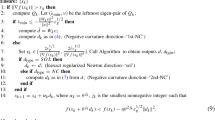Abstract
This paper is about a new concept for the description of 3D smooth surfaces: the extremal mesh. In previous works, we have shown how to extract the extremal lines from 3D images, which are the lines where one of the two principal surface curvatures is locally extremal. We have also shown how to extract the extremal points, which are specific points where the two principal curvatures are both extremal. The extremal mesh is the graph of the surface whose vertices are the extremal points and whose edges are the extremal lines: it is invariant with respect to rigid transforms. The good topological properties of this graph are ensured with a new local geometric invariant of 3D surfaces, that we call the Gaussian extremality, and which allows to overcome orientation problems encountered with previous definitions of the extremal lines and points. This paper presents also an algorithm to extract the extremal mesh from 3D images, and experiments with synthetic and real 3D medical images show that this graph can be extremely precise and stable.
Similar content being viewed by others
References
Bajal, C.L. and Ihm, I. 1992. Smoothing polyhedra using implicit algebraic splines. Compuer Graphics, 26(2):79–88.
Cutting, C.B., Bookstein, F.L., Haddad, B., Dean, D., and Kim, D. 1993. A spline-based approach for averaging three-dimensional curves and surfaces. SPIE, Mathematical Methods in Medical Imaging II, 2035:30–44.
Do Carmo, M.P. 1976. Differential Geometry of Curves and Surfaces. Prentice Hall.
Koenderink, J.J. 1990. Solid Shape. The MIT Press.
Lorensen, W.E. and Cline, H.E. 1987. Marching cubes: A high resolution 3D surface reconstruction algorithm. Computer Graphics, 21(4).
Monga, O., Benayoun, S., and Faugeras, O.D. 1992. Using partial derivatives of 3D images to extract typical surface features. In IEEE, Proceedings CVPR'92, Urbana Champaign, Illinois, also an INRIA Research Report (1599).
Monga, O. and Benayoun, S. 1993. Using differential geometry in r 4 to extract typical surface features. IEEE Conference on Computer Vision and Pattern Recognition.
Morse, B.S., Pizer, S.M., and Liu, A. 1993. Multiscale medial analysis of medical images. IPMI'93, 13th International Conference, Springer-Verlag, Lecture Notes in Computer Science, 687: 112–131.
Porteous, I.R. 1983. The normal singularities of surfaces in r 3. Proceedings of Symposia in Pure Mathematics, American Mathematical Soceity, 40: 379–393.
Porteous, I.R. 1987. Ridges and umbilics of surfaces. The Mathematics of Surfaces, R.R., Martin (Ed.), Clarendon Press: Oxford, Vol II, pp. 447–458.
Sander, P.T. and Zucker, S.W. 1992. Singularities of principal direction fields from 3D images. IEEE Trans. on Pattern Analysis and Machine Intelligence, 14(3):309–317.
Subsol, G., Thirion, J.P., and Ayache, N. 1994. Steps towards automatic building of anatomical at lases. In Visualization in Biomedical Computing'94.
Taubin, G. 1993. An improved algorithm for algebraic curve and surface fitting. 4th Int. Conf. on Computer Vision.
Thirion, J.-P. 1994. Extremal points: Definition and application to 3D image registration. In IEEE Conf. on Computer Vision and Pattern Recognization, Seattle.
Thirion, J.-P. and Gourdon, A. 1992. The 3D marching lines algorithm and its application to crest lines extraction. Technical Report 1672, INRIA.
Thirion, J.-P. and Gourdon, A. 1993. The 3D marching lines algorithm: New results and proofs. Technical Report 1881, INRIA.
Thirion, J.-P. and Benayoun, S. 1993. Image surface extremal points, new feature points for image registration. Technical Report 2003, INRIA.
Vemuri, B.C., Mitiche, A., and Aggarwal, J.K. 1986. Curvature based representation of objects from range data. Image and Vision Computing, 4(2):107–114.
Wyvill, G., McPheeters, C., and Wyvill, C. 1986. Data structures for soft objects. Visual Computer, 2:227–234.
Author information
Authors and Affiliations
Rights and permissions
About this article
Cite this article
Thirion, JP. The extremal mesh and the understanding of 3D surfaces. Int J Comput Vision 19, 115–128 (1996). https://doi.org/10.1007/BF00055800
Issue Date:
DOI: https://doi.org/10.1007/BF00055800




